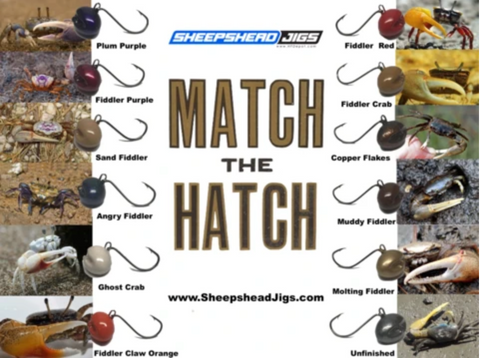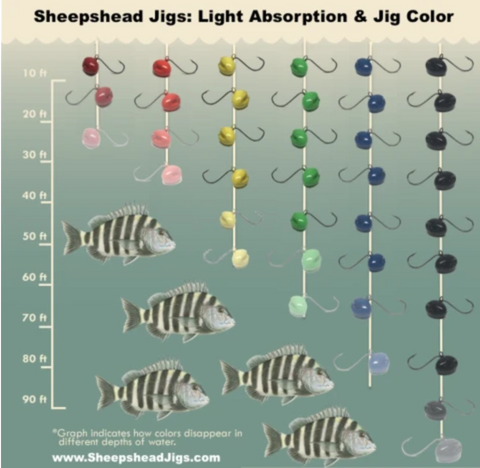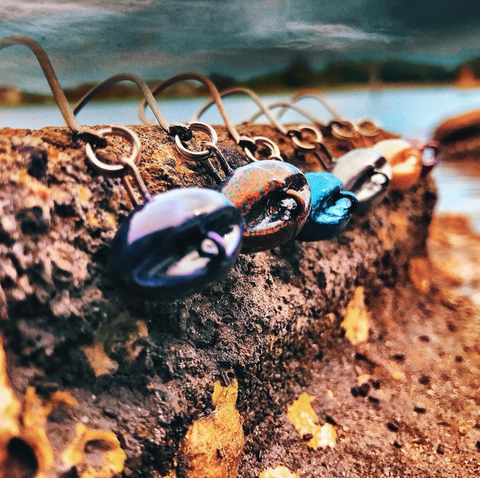The reason the color of your sheepshead jig matters is because different colors look better in different waters. Since sheepshead are found throughout the East Coast and Gulf Coast, a specific color in one area will work better than color in another. Many anglers get into the practice of using the same color over and over that they have had prior success. We are here to debunk this method and provide you with a scientific means as to the colors you should be fishing. We have come up with three reasons the colors of your sheepshead jigs will affect your bite.

Sheepshead Jig Color Matters: Match The Hatch
The Color Of Your Sheepshead Jig Is Important When Sheepshead Fishing
1) Sheepshead Jig Colors Matter: Match The Hatch

Match The Hatch With Your Sheepshead Jig
One of the main reasons the colors of your jig head matters when it comes to sheepshead fishing is that you are trying to mimic the natural colors of the sheepshead bait. Fiddler crabs are one of the go-to baits for catching sheepshead fish. If you are trying to fool a sheepshead with a sheepshead jig, it needs to match the colors that are found on the fiddlers they are eating. Fiddler crabs provide a variety of colors found on their claws, legs, or body. It will vary from tan, brown, orange, red, or purple. There are many different shades in between. Because of this, finding the perfect color for catching your sheepshead can be a challenge. In my experience catching a few fiddler crabs around the dock and using the colors of jigs that match up to them is the way to go. If you match the hatch, the likelihood of catching sheepshead will increase. You have full control of this and can usually plan accordingly. There are several factors that you do not have control over that will affect the way your jig heads will look in the water.
2) Water Clarity & Color Affects Sheepshead Jig Color
Water is one of the main absorbents or deflectors of light. Because of this, your jig heads can ultimately disappear due to the sun's white light. One thing anglers must always remember is water clarity will directly affect the color of your sheepshead jigs. You may think of this as common sense, but often it is overlooked when inshore fishing. Several factors that can affect the water clarity is the weather. Weather can make or break a fishing trip. It is also true that is can affect the fishing for several days after a significant weather event. One way this occurs is with the water clarity. Hard rain can muddy the water and shut down the bite. Currents can also affect the clarity of the water. The water is always more clear at high tide than it is at low tide. A lot of this has to do with the water.
3) Water Depth And Sheepshead Jig Colors
Water depth has a direct effect on the color of the sheepshead jigs you use. The deeper you are fishing, the more likely your color jig heads will not be effective. As a general rule, your blues and blacks are better at all depths than your brightly colored reds and yellows. This is important to remember because sheepshead fish are caught both inshore and offshore fishing. The water depths will vary from a couple of feet inshore to 100 ft. wrecks offshore. Fishing with the wrong jig color at specific depths can restrict your bite and turn the fish away. The way sheepshead perceive color underwater is different than what the angler views before he drops the jig down. White colors will appear bluish or grey underwater. Reds and yellows will appear dark brown or even black as it passes the 40 ft. mark. Knowing exactly how light affects sheepshead jigs will help you pick the best color for the area you are fishing.

As an angler is best to know the science as to why you should be fishing with certain colors. When looking at the color spectrum, it is best to remember that reds have a higher rate of absorption due to their longer wavelengths, and your blues have a lesser rate of absorption due to their shorter wavelengths. It is because of this principle that fish perceive the colors differently at different depths. As the depth of the water increases, the recognized colors are altered significantly, affecting the bite.
There are always environmental factors that will affect this more or less at times. Several of these include sunlight, cloud coverage, water clarity, and if any algae or microorganisms are suspended in the water. When trying to understand how sunlight affects absorption and color, you must realize how sunlight penetrates the water. At any given point on the water, you have 100% light hitting the water's surface. From this, only about 25% of the light will make it past the 30-foot mark. If you think about it in percentages at 100 feet deep, you may only see 5 to 10% light penetration. This is the reason at deeper depths it is a dark world because of the loss of light absorption. To correlate it back to sheepshead jigs, your darker blues and blacks will maintain their colors better because they require less light absorption due to their short wavelengths in an already reduced light penetrating state.
When picking your sheepshead jig to use at a specific depth, it is best to remember that the first color to disappear to our vision is reds. This will occur around a depth of 15 to 20 feet deep. The next color you will see disappear is orange, yellow, greens, and purples. Blues and blacks are the two colors that penetrate the deepest and maintain their color to both humans and fish.

Sheepshead Jig Colors Matter
Depending on the area you are fishing, the color could be the last thing you worry about, or it could be the most important. If you polled 50 sheepshead anglers about the colors of jigs they prefer, you could get 25 different colors, but they will all be around certain shades. These colors will revolve around the natural colors of the fiddler crab; therefore, by matching the hatch will significantly increase your chances of bites. Several other environmental factors will affect the colors of your jigs like water depth, water clarity, and watercolor. If you are offshore fishing for sheepshead at a bottom more significant than 40 feet or more profound than your blues are going to be the way to go. If you are inshore fishing for sheepshead, then matching the color to your bait is more critical. Matching the hatch is essential for attracting sheepshead to your jigs and enticing a bite. A good rule to remember is only to buy colors that you find on fiddler crabs. Sheepshead jigs are made in the shape of a fiddler crab, so maintaining colors is as important.
If you have any questions, comments, or concerns, please feel free to leave us a comment below or email us at [email protected]. We would love to hear about your sheepshead fishing experiences. We would also like to see all of your sheepsheads catches, so make sure you send us all your great pics to be featured on our social media pages. Make sure to check out our sheepshead Species page and sheepshead nation for other great sheepshead related blogs. Find informative information on fishing for sheepshead, chumming for sheepshead, finding fiddlers for bait, filleting sheepshead, or amazing sheepshead recipes. Know the waters you will be fishing, the bait you will be using, and match the hatch for a successful day inshore or offshore fishing for sheepshead.


Leave a comment